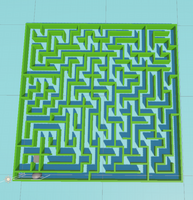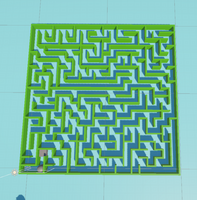Procedurally generated Maze Implementation



Added a Maze generation system, which will create a unique maze every time we play a new game.
I have used DFS (depth-first search) with recursive backtracking for generating the Maze. The Maze consists of grid cells where each cell takes a cell prefab to present it in the game environment.
Detailed explanation of my Maze Generation code:
Class Structure
Class Name
MazeGenerator
Fields
Serialized Fields
-
MazeCell mazeCellPrefab-
Prefab for individual maze cells.
-
-
Transform mazeHolder-
Parent transform to hold the maze cells in the hierarchy.
-
-
int mazeWidth-
Width of the maze grid.
-
-
int mazeLength-
Length of the maze grid.
-
Private Fields
-
MazeCell[,] mazeGrid-
2D array representing the maze grid structure.
-
Methods
1. void Start()
Initializes the maze grid and begins the maze generation process.
Key Steps
-
Grid Initialization:
-
Instantiates
MazeCellprefabs for every cell in the grid based onmazeWidthandmazeLength. -
Places cells in the correct position and stores them in the
mazeGridarray.
MazeCell cell = Instantiate(mazeCellPrefab, new Vector3(x, 0, z), Quaternion.identity); cell.SetCoordinates(x, z); mazeGrid[x, z] = cell;
-
-
Maze Generation:
-
Starts the maze generation using a coroutine.
-
Initial cell:
(0, 0).
StartCoroutine(GenerateMaze(null, GetACell(0, 0)));
-
2. MazeCell GetACell(int x, int z)
Retrieves the maze cell at the specified coordinates (x, z).
3. IEnumerator GenerateMaze(MazeCell previousCell, MazeCell currentCell)
Recursive coroutine that generates the maze using depth-first search.
Key Steps
-
Marks the
currentCellas visited.currentCell.Visit();
-
Clears the wall between
previousCellandcurrentCell.ClearWalls(previousCell, currentCell);
-
Waits for a short duration to visualize the generation.
yield return new WaitForSeconds(0.1f);
-
Recursively generates the maze for unvisited neighboring cells.
MazeCell nextCell = GetANewUnVisitedCell(currentCell); if (nextCell != null) { yield return GenerateMaze(currentCell, nextCell); } else { yield break; }
4. MazeCell GetANewUnVisitedCell(MazeCell currentCell)
Finds and returns a random unvisited neighboring cell of currentCell.
Process
-
Uses
GetUnvisitedNeighbourCellsto get all unvisited neighbors. -
Selects one randomly using
Random.Range. -
Returns
nullif there are no unvisited neighbors.
5. List<MazeCell> GetUnvisitedNeighbourCells(MazeCell currentCell)
Retrieves a list of unvisited neighbors for a given cell.
Process
-
Extracts the cell’s coordinates.
-
Checks each neighboring direction (left, right, forward, backward).
-
Adds unvisited neighbors to a list.
-
Ensures neighbors are within grid bounds using
CheckBound.
6. bool CheckBound(int x, int z)
Verifies if the coordinates (x, z) are within the grid bounds.
Logic
if ((x >= 0 && x < mazeWidth) && (z >= 0 && z < mazeLength)) { return true; } else { return false; }
7. void ClearWalls(MazeCell previousCell, MazeCell currentCell)
Removes walls between two neighboring cells to create a path.
Wall Clearing Logic
-
Determines the direction between
previousCellandcurrentCell. -
Clears the walls accordingly:
-
Left -> Right: Clears
rightwall ofpreviousCellandleftwall ofcurrentCell. -
Right -> Left: Clears
leftwall ofpreviousCellandrightwall ofcurrentCell. -
Back -> Front: Clears
frontwall ofpreviousCellandbackwall ofcurrentCell. -
Front -> Back: Clears
backwall ofpreviousCellandfrontwall ofcurrentCell.
-
Dependencies
1. MazeCell Class
Represents individual cells of the maze. Must include:
-
float X, Z: Coordinates of the cell. -
bool isVisited: Indicates whether the cell has been visited. -
void Visit(): Marks the cell as visited. -
void ClearWall(CellWalls wall): Clears a specified wall. -
void SetCoordinates(int x, int z): Sets the cell’s coordinates.
2. CellWalls Enum
Defines the walls of a cell (e.g., left, right, front, back).
Notes
-
Dynamic Cell Size:
-
Currently assumes a cell size of
1 unit. -
To handle different sizes, adjust positions during instantiation (e.g., multiply coordinates by the cell size).
-
-
Maze Visualization:
-
The coroutine includes a
WaitForSecondsdelay to visualize the generation process step-by-step.
-
Check out this for code implementation: Maze
Maze Escape
Navigate the maze, grab the diamond, survive the hunt!
| Status | Prototype |
| Author | Goutamraj |
| Genre | Action |
| Tags | Singleplayer, Top down shooter |
More posts
- Diwali_Rifle Code Implementation😁May 19, 2025
- Sword Weapon Code ImplementationMay 13, 2025
- New Sword Weapon and Dash abilityMay 11, 2025
- Hit Effects and Mini MapMay 04, 2025
- Player Movement Animations with Blend TreeApr 28, 2025
- Add Precision Aim for Player and Update Guard Enemy with Laser MechanicsApr 20, 2025
- Guard Enemy ImplementationApr 14, 2025
- Guard EnemyApr 10, 2025
- Enemy PoolApr 08, 2025
- Enemy Handling SystemApr 06, 2025

Leave a comment
Log in with itch.io to leave a comment.